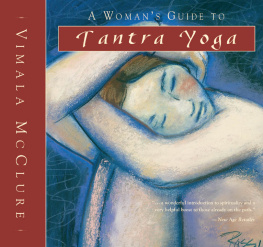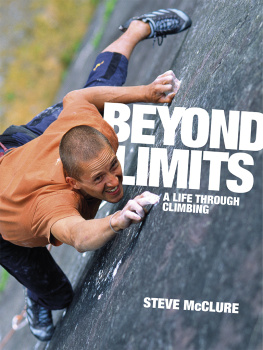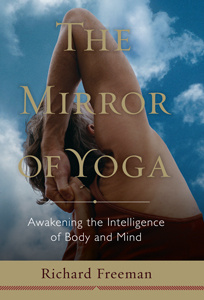
A WOMANS GUIDE TO
Tantra Yoga
A WOMANS GUIDE TO
Tantra Yoga
Vimala McClure

New World Library
Novato, California

New World Library
14 Pamaron Way
Novato, CA 94949
1997 Vimala McClure
Cover illustration by Pam Rossi
Cover and text design by Aaron Kenedi
Illustrations by Michael B. McClure
All rights reserved. This book may not be
reproduced in whole or in part, or transmitted in any form,
or by any means electronic, mechanical, photocopying,
recording, or other, without written permission from the
publisher, except by a reviewer who may quote
brief passages in a review.
Library of Congress Cataloging-in-Publication Data
McClure, Vimala Schneider, 1952
(Some still want the moon)
A womans guide to tantra yoga / Vimala McClure.
p. cm.
Originally published: Some still want the moon. Willow Springs, MO :
Nucleus Publications, 1989
ISBN 1-57731-017-9 (pbk. : alk. paper)
1. Yoga. 2. Tantrism. 3. Women Conduct of life. I. Title.
[b132.Y6M373 1997] 96-54836
291.436dc21 CIP
First printing, May 1997
Printed in Canada on acid-free paper
ISBN 1-57731-017-9
Distributed to the trade by Publishers Group West
10 9 8 7 6 5 4 3 2 1
Dedicated to P. R. Sarkar
Acknowledgments
The author wishes to thank Michael McClure, Joni Zweig, Tom Barefoot, Christina Davis, and Barbara Parham for their help and support.
Contents
Conscious Layer
Suggested Schedule for Beginners
Santosa in Parenting
I n 1971, I was nineteen years old. After a tumultuous adolescence I was searching for some positive direction for my life. A creek ran by the small house where I lived and I sat by it every day that summer, trying to unravel the truth about life and my place in it. I began reading books about yoga, which led me to an interest in adopting a vegetarian diet. One day in the health food store I saw a notice for a free yoga class. I took the class and was so impressed by the instructor and by the changes that a simple daily routine of yoga and meditation brought into my life that I continued to study and practice. Eventually I began to teach, and my curiosity led me to India, where I met my spiritual teacher and transformed my life through study of the teachings of the vast body of work called Tantra Yoga, and through service to the poor.
Many years and many changes have occurred in my life since then, but one constant is my daily practice. Tantric meditation has provided me with a spiritual base upon which I have built the rest of my life. It is a daily alchemy, turning the dross of my minds wanderings into the golden treasure of spiritual realization. I cannot imagine my life without this treasure. I have not had an easy life, nor have I always understood the meaning of its trials, but my meditation has always brought me into focus, provided me with strength to prevail over pain and loss, and inspired me to continue to find my way to health and positivity. It has nurtured my desire to contribute whatever I can to the betterment of my world, and helped me to find creative ways to do so. The intuitive capabilities I have developed and the love I feel for people (which allows me to communicate well with parents and babies with whom I often work as an educator and counselor) are a direct result of my daily spiritual work.
A book like this one introduced me to Tantra Yoga, its underlying philosophy, and the benefits of meditation. This book explores a wide range of areas, sometimes with the perspective of Western science, sometimes with teachings from the East. I go into depth with a variety of things and not all of them may interest you at this stage of your life. Thats fine just skip over what doesnt grab your attention at the moment, and read and reflect on what does.
I wrote this book with a desire to provide other women with an invitation. The words certainly apply to men as well: No one can walk your spiritual path for you; each step must be taken consciously, by you alone. No guru, guide, or channel can do the inner work that is necessary to develop your higher capabilities and bring you to the realization that answers your deepest questions. Make yourself very still, and listen quietly with openness. You will be led to what you need at every point along the way.
T antra is the oldest Eastern tradition of spiritual philosophy and practice, having originated more than 7,000 years ago in India. From its origin to the present day, it is a revolutionary approach to human evolution. The word Tantra means liberation through mental expansion, and the word yoga means union, in this case the unity of the self and all creation with the source of all being. The basic tenet of Tantra is that all of life is food for spiritual development, from the most mundane tasks of everyday living to the deepest meditation. Tantra teaches us to embrace life, to strive to see the Creator in everything within and around us. The practices, including concentration, meditation, yoga postures, relaxation, visualization, nourishing food, community involvement, service, and right conduct, are all designed to help us experience body, mind, spirit, joy, peace, suffering, and pain as changing aspects of one indivisible Being.
You may have heard Tantra referred to as the yoga of sex. While sexuality is a part of Tantra because it is a part of life, it is not the core of Tantric philosophy or practice. In closely, clarifying the underlying tradition that led to this misinterpretation of Tantras focus and meaning. Practitioners of Tantra often refer to it as the yoga of everything. Unlike many religious philosophies that separate the spiritual from the mundane by rejecting that which is not overtly spiritual, Tantra teaches us that in order to realize our oneness with the Supreme Being we must accept, not reject. We must embrace life in all of its struggle and pain, and through this profound acceptance we will find peace and experience freedom from the bondage of self-imposed limitation.
Chapter One
Your Perfect Nature
Some people, no matter what you give them, still want the moon.
Denise Levertov, Adams Complaint
G aze, for a while, at the vast expanse of the ocean. Its surface is turbulent, waves crashing, spewing millions of water droplets into the air. But as you dive deeper, the turbulence subsides; at its depths is silence and peace. Ordinarily you may experience only the surface of your minds potential the crashing waves of emotion, millions of thoughts like tiny drops of water flying in every direction. Meditation helps you dive deeply into your mind, and in the process, uncover hidden treasures.
As you discover the deeper aspects of your mind, you become better able to control your thoughts, your actions, and your reactions to the external world. Who am I? Where did I come from? and Why am I here? are questions whose answers are revealed as your feeling of individual existence merges with infinite awareness.
In another way, your mind is like the ocean reflecting the image of the moon. It is possible to see the reflection of the moon on the water only when the water is calm, not when the waves are turbulent. Similarly, pure consciousness is only revealed when your mind is calm and still, when the agitated waves of thought and desire cease.
Next page









